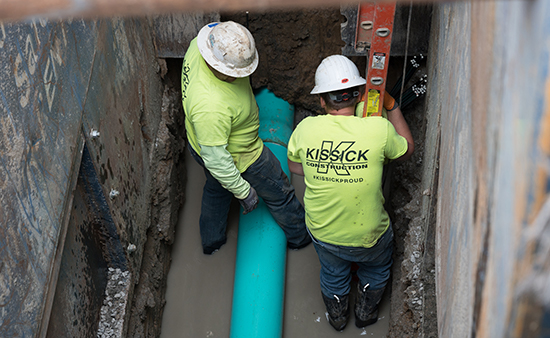Gooseneck Creek North Neighborhood Sewer Rehabilitation
Construction Projects in Kansas City
Utilities, Trenchless Technology
In the Northeast quadrant of the City just south of the Missouri River lies a mainly residential area featuring homes dating back to the late 1800s. At that time, sewer lines were laid within narrow easements and ran parallel to or under historic homes, bridges, mature trees, sheds, fences, alleys, unrecognized structures and private improvements. Today, this area is an active pedestrian and biking area. It weaves through historic bridges, roads, and trails, and draws users from throughout the Kansas City metro area.
The City of Kansas City, Missouri, Water Services Department determined that many of the aging sewers in the area were in poor structural condition: tree roots were growing in pipes, connecting joints were failing, lateral cracking was occurring, and there was poor connectivity between the laterals and main line. All of these challenges led to significant sewer concerns and capacity challenges. Results from a cost-benefit analysis determined that trenchless technology procedures would be the most cost-effective method of construction to extend the life of the existing sewer.

Technological advancements and applications, including innovative pipe bursting, were utilized during the project. In particular, an aging sewer line located under a historic bridge had started to collapse. Our options were limited on its replacement due to the age of the bridge and the infrastructure replacement costs associated with nearby pavement and streetscape. The pipe bursting approach allowed Kissick to rehabilitate the sewer line without disruption to the historic bridge.
The complexity of the project was increased due to the historic nature of the surrounding neighborhood. Many parts of the sewer line were buried over 20 feet deep with inadequate and narrow easements and yards that were encumbered with structures, fences and large trees. Each service lateral repair was unique. Some required repair at the connection to the main, while others were two, four, ten, or up to 15 feet into the lateral line. Additionally, some laterals required full lining to accomplish the desired result.
With significant planning and preparation, Kissick was able to map out the repairs prior to the start of construction. And with thoughtful approaches and effective communication strategies, the project superintendent and construction team were able to diminish disruption to neighborhoods within the impacted area.
